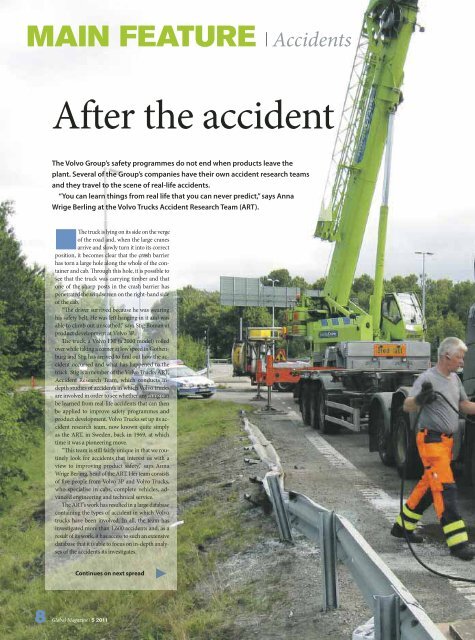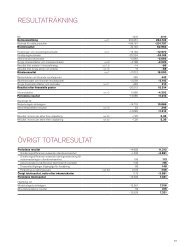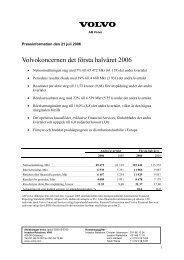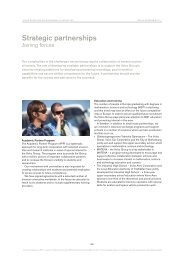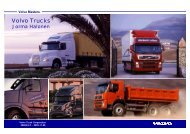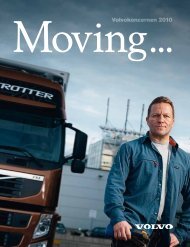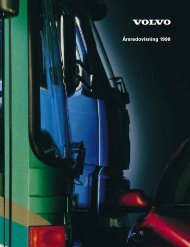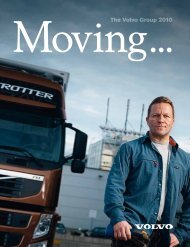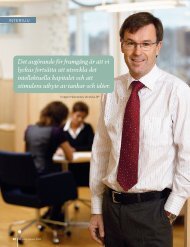After the accident - Volvo
After the accident - Volvo
After the accident - Volvo
- No tags were found...
You also want an ePaper? Increase the reach of your titles
YUMPU automatically turns print PDFs into web optimized ePapers that Google loves.
MAIN FEATURE I Accidents<strong>After</strong> <strong>the</strong> <strong>accident</strong>The <strong>Volvo</strong> Group’s safety programmes do not end when products leave <strong>the</strong>plant. Several of <strong>the</strong> Group’s companies have <strong>the</strong>ir own <strong>accident</strong> research teamsand <strong>the</strong>y travel to <strong>the</strong> scene of real-life <strong>accident</strong>s.“You can learn things from real life that you can never predict,” says AnnaWrige Berling at <strong>the</strong> <strong>Volvo</strong> Trucks Accident Research Team (ART).■The truck is lying on its side on <strong>the</strong> vergeof <strong>the</strong> road and, when <strong>the</strong> large cranesarrive and slowly turn it into its correctposition, it becomes clear that <strong>the</strong> crash barrierhas torn a large hole along <strong>the</strong> whole of <strong>the</strong> containerand cab. Through this hole, it is possible tosee that <strong>the</strong> truck was carrying timber and thatone of <strong>the</strong> sharp posts in <strong>the</strong> crash barrier haspenetrated <strong>the</strong> windscreen on <strong>the</strong> right-hand sideof <strong>the</strong> cab.“The driver survived because he was wearinghis safety belt. He was left hanging in it and wasable to climb out unsca<strong>the</strong>d,” says Stig Boman atproduct development at <strong>Volvo</strong> 3P.The truck, a <strong>Volvo</strong> FM (a 2000 model) rolledover while taking a corner at low speed in Go<strong>the</strong>nburgand Stig has arrived to find out how <strong>the</strong> <strong>accident</strong>occurred and what has happened to <strong>the</strong>truck. Stig is a member of <strong>the</strong> <strong>Volvo</strong> Trucks ART,Accident Research Team, which conducts indepthstudies of <strong>accident</strong>s in which <strong>Volvo</strong> trucksare involved in order to see whe<strong>the</strong>r anything canbe learned from real-life <strong>accident</strong>s that can <strong>the</strong>nbe applied to improve safety programmes andproduct development. <strong>Volvo</strong> Trucks set up its <strong>accident</strong>research team, now known quite simplyas <strong>the</strong> ART, in Sweden, back in 1969, at whichtime it was a pioneering move.“This team is still fairly unique in that we routinelylook for <strong>accident</strong>s that interest us with aview to improving product safety,” says AnnaWrige Berling, head of <strong>the</strong> ART. Her team consistsof five people from <strong>Volvo</strong> 3P and <strong>Volvo</strong> Trucks,who specialise in cabs, complete vehicles, advancedengineering and technical service.The ART’s work has resulted in a large databasecontaining <strong>the</strong> types of <strong>accident</strong> in which <strong>Volvo</strong>trucks have been involved. In all, <strong>the</strong> team hasinvestigated more than 1,600 <strong>accident</strong>s and, as aresult of its work, it has access to such an extensivedatabase that it is able to focus on in-depth analysesof <strong>the</strong> <strong>accident</strong>s its investigates.Continues on next spread>8 Global Magazine ı 5 2011
By: Karin WikPhotography: Accident Research TeamGlobal Magazine ı 5 20119>
Accidents“Thank goodness<strong>accident</strong>s are so rareand this is due primarilyto proactive work”Lars-Olof Winterfeldt, chief engineerfor <strong>Volvo</strong> Aero’s products>“It is, for example, really interesting to find outwhe<strong>the</strong>r a new model functions as it does in our tests.We often find that a truck functions as it is supposedto, but every <strong>accident</strong> is still unique in its own way.This helps us to find new crash situations from whichwe can learn and identify improvements for future<strong>Volvo</strong> trucks,” explains Anna Wrige Berling.“That’s why we always try to interview <strong>the</strong> driverabout his or her experience. This is extremely import -ant for us.”She goes on to explain that many drivers still donot use a safety belt and that finding ways of persuadingdrivers to do so is a challenge.“It’s partly a question of comfort. Many drivers frequentlyhave to jump in and out of <strong>the</strong>ir cabs andmany of <strong>the</strong>m also think that <strong>the</strong> safety belt doesn’t fitwell and chafes when <strong>the</strong> truck bumps up and down.”THE CURRENT DRIVER’S SEAT with “belt in seat” – ino<strong>the</strong>r words, <strong>the</strong> shoulder strap is fitted to <strong>the</strong> backrestinstead of <strong>the</strong> cab – has improved <strong>the</strong> comfort, butAnna Wrige Berling says that work still needs to bedone to increase <strong>the</strong> use of <strong>the</strong> safety belt.In <strong>the</strong> <strong>accident</strong> in Go<strong>the</strong>nburg that Stig Bomanhas travelled to investigate, <strong>the</strong> driver is shaken butunhurt, thanks to his safety belt and <strong>the</strong> rigid cab.Stig interviews <strong>the</strong> driver and studies <strong>the</strong> scene of <strong>the</strong><strong>accident</strong> in detail. Roll-overs are relatively commonand, even if a more detailed examination is needed tobe completely sure, he has a pretty good idea of <strong>the</strong>cause.“As it’s laden with sawn timber, <strong>the</strong> centre of gravitywas probably high. Containers like this one are usuallysealed, so <strong>the</strong> driver doesn’t know how <strong>the</strong>y are loaded.This can be a disadvantage.”The ART’s investigations are based on collaborationwith <strong>the</strong> police, <strong>the</strong> recovery service, customers anddrivers. It travels to between 20 and 25 <strong>accident</strong>s ayear, <strong>the</strong> majority in Sweden, but it also visits o<strong>the</strong>rEuropean countries. The team also investigates <strong>accident</strong>sinvolving trucks and cars, primarily to see how<strong>the</strong> under-run protection system works.All <strong>the</strong> information is collated and analysed by <strong>the</strong>ART and o<strong>the</strong>r experts within <strong>the</strong> <strong>Volvo</strong> Group and<strong>the</strong>y sometimes take things even fur<strong>the</strong>r and repeatparts of <strong>the</strong> <strong>accident</strong> sequence to make comparisonswith ma<strong>the</strong>matical models.VOLVO BUSES ALSO INVESTIGATES real-life <strong>accident</strong>s,but its ART works in a slightly different way from <strong>the</strong>one at <strong>Volvo</strong> Trucks. It focuses primarily on investigatingwhe<strong>the</strong>r <strong>the</strong> <strong>Volvo</strong> product has contributed to<strong>the</strong> <strong>accident</strong> and whe<strong>the</strong>r <strong>Volvo</strong> needs to take anykind of action. It also aims to help customers who areStig Boman, <strong>Volvo</strong> 3P, is a member of <strong>the</strong> Accident Research Team.interested in <strong>the</strong> cause in order to prevent an <strong>accident</strong>being repeated. Every year, some 20 fires are investigated,toge<strong>the</strong>r with a small number of o<strong>the</strong>r serious<strong>accident</strong>s.“Fortunately, serious <strong>accident</strong>s involving buses arerare,” says Frede Overby, <strong>accident</strong> research managerat <strong>Volvo</strong> Buses and <strong>the</strong> person who travels to investigate<strong>accident</strong>s.Frede subscribes to press cuttings and receives reportson bus <strong>accident</strong>s from all over <strong>the</strong> world. Whenhe learns that a <strong>Volvo</strong> bus has been involved, he makesphone calls to find out what has happened. He issometimes contacted by customers who have encounteredproblems with <strong>the</strong>ir buses and want to knowwhy. If Frede finds something he thinks needs to beinvestigated, he takes fur<strong>the</strong>r action. As <strong>the</strong>re are <strong>Volvo</strong>buses in most countries, he travels all over <strong>the</strong> worldif necessary.“It’s a bit like being a detective, especially if <strong>the</strong>rehas been a fierce fire and all that is left is scrap metal.You find small traces and you have to build from that,”explains Frede.Interviewing <strong>the</strong> driver is an important part of <strong>the</strong>work. Was he or she able to brake? Did any error messagesappear on <strong>the</strong> display? It is also important tocheck <strong>the</strong> repair history.Magnus Bergström andrules governing safety“This is an incredibly exciting job and you aredriven <strong>the</strong> whole time by <strong>the</strong> positive aspect of preventingsimilar <strong>accident</strong>s happening again,” says Frede.A FEW YEARS AGO, <strong>the</strong> <strong>Volvo</strong> Buses ART was able tohelp solve <strong>the</strong> problem of a number of engine bayfires in <strong>Volvo</strong> buses where an engine jet pipe had brokenand sprayed diesel oil over hot parts of <strong>the</strong> engine.It transpired that <strong>the</strong> problems occurred when one of<strong>the</strong> total of six jet pipes needed to be replaced duringmaintenance. These jet pipes sit in two groups of threeand, to make room for a new pipe, <strong>the</strong> mechanic wasforced to bend it, <strong>the</strong>reby weakening <strong>the</strong> material. Asa result of this discovery, <strong>Volvo</strong> Parts, <strong>Volvo</strong> Buses’parts supplier, stopped selling single jet pipes andstarted selling <strong>the</strong>m in packs of three, with <strong>the</strong> resultthat a new, more straightforward working methodwas introduced. If a single pipe needs replacing, allthree are now replaced without needing to bend one.“A huge amount of work takes place behind <strong>the</strong>scenes, in addition to <strong>the</strong> actual <strong>accident</strong>s,” says Frede.“We are involved in continuous product development,where our work focuses primarily on eliminating<strong>the</strong> risk of fire,” adds Frede Overby.In some countries, like Sweden, all bus <strong>accident</strong>sinvolving fatalities are investigated by a government10 Global Magazine ı 5 2011
The truck has rolled over at low speed while cornering and has landed on <strong>the</strong> crash barrier.Cicci JonsonAccident Research TeamLars-Olof Winterfeldt at <strong>Volvo</strong> Aero describe <strong>the</strong> rigorousprogrammes in <strong>the</strong> aircraft industry.Photo Jukka Lamminluotoagency and Frede <strong>the</strong>n helps to produce <strong>the</strong> information<strong>the</strong> government inquiry needs.WHEN IT COMES TO VOLVO AERO, which producescomponents for aircraft engines, work on quality andsafety is governed by rigorous regulations, legislationand standards that apply to <strong>the</strong> whole of <strong>the</strong> internationalaircraft industry.“Thank goodness <strong>accident</strong>s are so rare and this isdue primarily to proactive work,” says Lars-Olof Winterfeldt,chief engineer for <strong>Volvo</strong> Aero’s products, toge<strong>the</strong>rwith Magnus Bergström.If an air <strong>accident</strong> happens anywhere in <strong>the</strong> world,it is always investigated by a government <strong>accident</strong>commission. A commission of this kind contacts <strong>the</strong>engine manufacturer who <strong>the</strong>n contacts <strong>Volvo</strong> Aeroif <strong>the</strong>re is a suspicion that any of <strong>Volvo</strong> Aero’s productsare involved“We are <strong>the</strong>n on our toes and ready with all <strong>the</strong> informationabout our components,” says Lars-Olof,who can actually only remember one occasion, 15years ago, when a component from <strong>Volvo</strong> Aero wasinvolved in an <strong>accident</strong>. During <strong>the</strong> <strong>accident</strong> inquiry,<strong>Volvo</strong> Aero produced all <strong>the</strong> information about <strong>the</strong>engine component – including <strong>the</strong> machines it hadpassed through, where <strong>the</strong> raw material came fromAnna Wrige Berling and Stig Boman enter facts relating to <strong>accident</strong>s in a database. In-depth analyses <strong>the</strong>n use<strong>the</strong>se data to improve safety.>“This is an incredibly exciting joband you are driven <strong>the</strong> whole timeby <strong>the</strong> positive aspect of preventingsimilar <strong>accident</strong>s happening again”Frede Overby, <strong>accident</strong> researchmanager at <strong>Volvo</strong> BusesGlobal Magazine ı 5 201111
Accidents“This team is still fairlyunique in that we routinelylook for <strong>accident</strong>s thatinterest us with a view toimproving product safety”AnnaLisa FotoAnna Wrige Berling, head of <strong>the</strong> ART,Accident Research Team>and how maintenance had been performed on <strong>the</strong>customer’s premises – within two hours.“The <strong>accident</strong> commission found that everythinghad been done in accordance with all <strong>the</strong> availableknowledge and current standards, but it still led eventuallyto changes being made to both <strong>the</strong> productionof that particular component and <strong>the</strong> global standardthat governed <strong>the</strong> production method,” explains MagnusBergström.REAL-LIFE ACCIDENTS ARE, however, <strong>the</strong> exceptionin <strong>Volvo</strong> Aero’s safety work. The greatest effort is insteaddevoted to what are known as incidents, devi -ations that do not turn into <strong>accident</strong>s.Within <strong>the</strong> aircraft industry, <strong>the</strong>re are what areknown as initiative requirements, which means thateveryone that handles <strong>the</strong> products, from assemblyworkers to calculation engineers, is responsible for issuingan alert if he or she suspects that something isnot as it should be. Toge<strong>the</strong>r with <strong>the</strong> quality systems,this leads, in virtually every case, to a defect beingrectified before components leave production.“This is completely normal and is part of our qualityand safety programme. In rare cases, however, we cansuspect a problem in a product that has alreadyreached <strong>the</strong> customer and this generates large-scaleactivity,” says Lars-Olof Winterfeldt.He describes what happened when it was discoveredthat a delivered component did not have exactly<strong>the</strong> desired characteristics.“We suspected that a component that was in <strong>the</strong>air might be unsafe. As a result, we initiated a majorinvestigation at <strong>Volvo</strong> Aero and at <strong>the</strong> customer, butwe eventually found that <strong>the</strong> product was fine. Wedidn’t need to change our hardware, but we updated<strong>the</strong> user instructions.”The user instruction books for <strong>Volvo</strong> Aero’s componentsare as thick as encyclopaedias and <strong>the</strong>y are aKenneth Kihlquist, <strong>Volvo</strong> Trucks, Ulf Torgilsman, <strong>Volvo</strong> 3P, Anna Wrige Berling, <strong>Volvo</strong> 3P, Dennis Mattsson,<strong>Volvo</strong> Trucks, Stig Boman, <strong>Volvo</strong> 3Ppart of <strong>the</strong> product that is just as important as <strong>the</strong>hardware.“These manuals guarantee <strong>the</strong> airworthiness of aproduct once development and production are completedand we must be active and inform users if <strong>the</strong>yare changed,” says Magnus Bergström.“The existence of <strong>the</strong> entire industry is dependenton <strong>the</strong> general public being able to rely on aircraft.”WORK AT THE VOLVO TRUCKS ART began in 1969 asa Swedish pioneering project in vehicle safety. Thecurrent Accident Research Team has spread not onlythroughout <strong>the</strong> Group but also all over <strong>the</strong> world. InJuly this year, <strong>the</strong> ART entered into a partnership with<strong>the</strong> China Automotive Technology and Research Centre,CATARC, <strong>the</strong> Chinese authorities’ organisationthat is responsible for research and certification relatingto <strong>the</strong> country’s traffic safety programmes. Thework resembles <strong>the</strong> work that is done in Sweden andEurope, but <strong>the</strong> objective is not to investigate individual<strong>accident</strong>s but to learn about traffic safety in Chinaon a wider level.“We don’t know how things are organised in China,so we need to learn and obtain basic documentationfor future decisions and priorities,” explains ClaesAvedal at product planning at <strong>Volvo</strong> 3P.“We need to learn more about <strong>the</strong> special trafficenvironment in China. It contains everything from<strong>the</strong> traffic systems of <strong>the</strong> future to outdated infrastructureand <strong>the</strong> things that apply this year will havechanged completely next year.”Within <strong>the</strong> framework of <strong>the</strong> project, <strong>the</strong> CATARCwill be conducting in-depth studies of several hundred<strong>accident</strong>s in a number of Chinese cities over a threeyearperiod. <strong>Volvo</strong> and a number of o<strong>the</strong>r vehiclemanufacturers will <strong>the</strong>n have <strong>the</strong> chance to study <strong>the</strong>information relating to <strong>the</strong>se <strong>accident</strong>s.“This partnership is aiming for broad-based, fundamentaltraffic safety. Nothing of this kind has previouslyexisted in China and so it is a truly pioneeringproject. Just like <strong>the</strong> work <strong>the</strong> ART began in Swedenin <strong>the</strong> 1960s,” says Claes Avedal. ■MORE INFORMATION ON THE WAY THE GROUP WORKS ON REAL-LIFE ACCIDENTSRenault TrucksDuring a period of 20 years (until <strong>the</strong> 2008-2009 financial crisis), Renault Trucks conducteddetailed analyses of truck <strong>accident</strong>s. A team of specialists travelled to <strong>the</strong>scenes of <strong>accident</strong>s to investigate and analyse. This work resulted in an extensive databasecontaining statistics from more than 1,000 <strong>accident</strong>s. This database is owned byRenault Trucks and is available to <strong>the</strong> whole of <strong>the</strong> <strong>Volvo</strong> Group for its work on productand traffic safety.Since 2008, Renault Trucks has been focusing primarily on <strong>accident</strong>s that involve vulnerableroad users, such a cyclists and pedestrians in urban environments, in whichdistribution vehicles are involved.MackMack supports customers and <strong>the</strong> authorities such as <strong>the</strong> National TransportationSafety Board when <strong>the</strong>y investigate <strong>accident</strong>s in which Mack vehicles have beeninvolved. Experts both internally at Mack and externally ga<strong>the</strong>r and analyse facts and<strong>the</strong>n take action.<strong>Volvo</strong> PentaIn special circumstances in connection with an <strong>accident</strong>, <strong>Volvo</strong> Penta sometimessends a team to take a closer look. This is not done systematically, however.12 Global Magazine ı 5 2011


